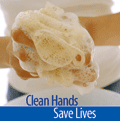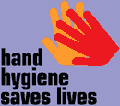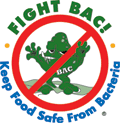Skip directly to the search box, site navigation, or content.
Keeping hands clean is one of the most important steps we can take to avoid getting sick and spreading germs to others. It is best to wash your hands with soap and clean running water for 20 seconds. However, if soap and clean water are not available, use an alcohol-based product to clean your hands. Alcohol-based hand rubs significantly reduce the number of germs on skin and are fast acting.
When washing hands with soap and water:
- Wet your hands with clean running water and apply soap. Use warm water if it is available.
- Rub hands together to make a lather and scrub all surfaces.
- Continue rubbing hands for 20 seconds. Need a timer? Imagine singing "Happy Birthday" twice through to a friend!
- Rinse hands well under running water
- Dry your hands using a paper towel or air dryer. If possible, use your paper towel to turn off the faucet
Remember: If soap and water are not available, use alcohol-based gel to clean hands.
When using an alcohol-based hand sanitizer:
- Apply product to the palm of one hand
- Rub hands together
- Rub the product over all surfaces of hands and fingers until hands are dry.
When should you wash your hands?
- Before preparing or eating food
- After going to the bathroom
- After changing diapers or cleaning up a child who has gone to the bathroom
- Before and after tending to someone who is sick
- After blowing your nose, coughing, or sneezing
- After handling an animal or animal waste
- After handling garbage
- Before and after treating a cut or wound
Featured Items
 Healthy School, Healthy People - It's a SNAP 2005 Award Recipients
Healthy School, Healthy People - It's a SNAP 2005 Award Recipients
Congratulations Ralston Middle School on being selected as the top recipient of the 2005 Healthy Schools, Healthy People - It's a SNAP award.
 View Dr. Gerberding's message (RealPlayer – 797 KB)
View Dr. Gerberding's message (RealPlayer – 797 KB)
Read the transcript
 Healthy Schools, Healthy People – It’s a SNAP
Healthy Schools, Healthy People – It’s a SNAP
A hands-on initiative for middle schools is designed to help keep students in school and learning by improving overall health through promoting clean hands.
 Clean Hands Coalition
Clean Hands Coalition
The Clean Hands Coalition (CHC) is a unified alliance of public and private partners working together to create and support coordinated, sustained initiatives to significantly improve health and save lives through clean hands.
 Hand Hygiene During an Emergency
Hand Hygiene During an Emergency
After an emergency, it can be difficult to find running water. However, it is still important to wash your hands to avoid illness. It is best to wash your hands with soap and water but when water isn’t available, you can use alcohol-based products made for washing hands...
 CDC Germstopper: Healthy Habits Keep You Well
CDC Germstopper: Healthy Habits Keep You Well
Healthy habits can protect everyone from getting germs or spreading germs at home, school, or work. Simple actions, like covering your mouth and nose and cleaning your hands often, can stop germs and prevent illnesses...
 Hand Hygiene in Healthcare Settings
Hand Hygiene in Healthcare Settings
Hand hygiene guidelines help healthcare workers reduce infections in health care settings to promote patient safety. Campaign includes materials to promote hand Hygiene in healthcare facilities.
 Fight BAC!® Partnership for Food Safety Education
Fight BAC!® Partnership for Food Safety Education
Wash hands in hot soapy water before preparing food and after using the bathroom, changing diapers and handling pets. For best results, use warm water to moisten hands and then apply soap and rub hands together for 20 seconds before rinsing thoroughly...
Remember, Clean Hands Save Lives!
* Links to non-Federal organizations found at this site are provided solely as a service to our users. These links do not constitute an endorsement of these organizations or their programs by CDC or the Federal Government, and none should be inferred. CDC is not responsible for the content of the individual organization Web pages found at these links.
Page last reviewed: November 22, 2006
Content Source: National Center for Zoonotic, Vector-Borne, and Enteric Diseases (ZVED)
Secondary Navigation
- FDA Nonprescription Drugs Advisory Committee - Benefits and risks of antiseptic products marketed for consumer use. Oct 20, 2005
- Antibacterial Cleaning Products and Drug Resistance. EID Journal, Oct 2005
- Results of ASM and SDA handwashing survey, Sept 2005
- Effect of handwashing on child health: a randomised controlled trial. The Lancet, July 16, 2005
- Effect of Intensive Handwashing Promotion on Childhood Diarrhea in High-Risk Communities in Pakistan. JAMA, June 2004
- CDC Food Safety Office
- Partnership for Food Safety Education
- Food Safe Schools Action Guide
